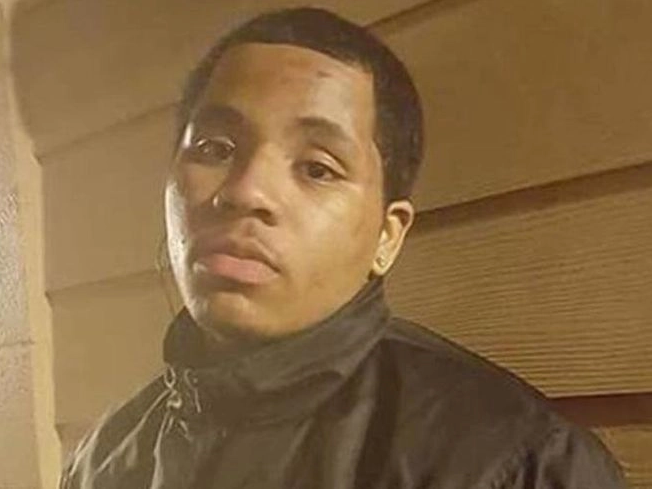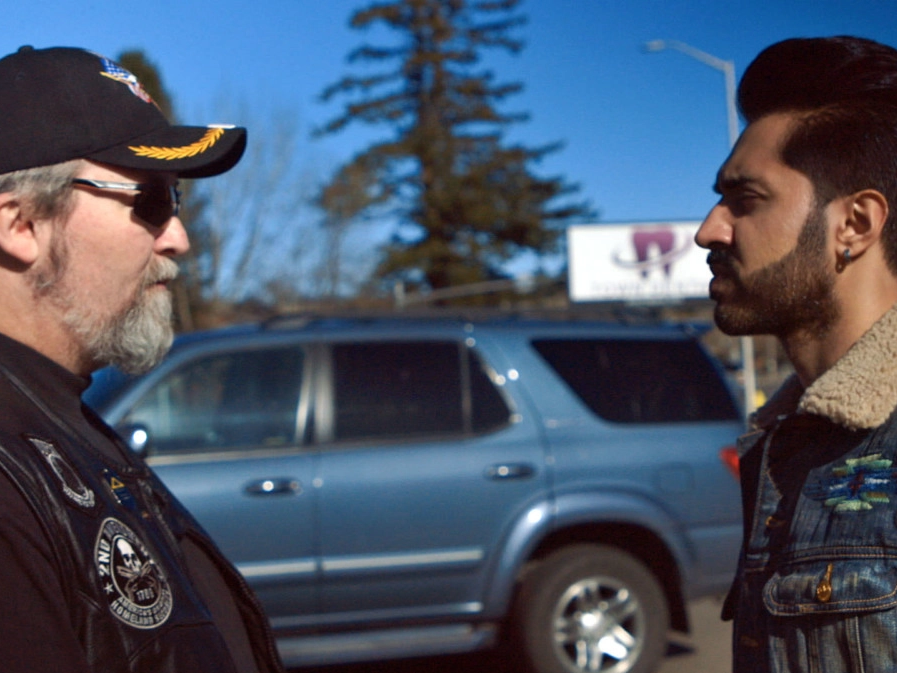How an Oregon murder trial reflected the true face of America
Mobeen Azhar ventured to Portland to document a murder trial, unearthing a tale of America’s sins in the process. As his resulting film, A Black and White Killing, is broadcast on the BBC, he reflects on what he encountered

Your support helps us to tell the story
From reproductive rights to climate change to Big Tech, The Independent is on the ground when the story is developing. Whether it's investigating the financials of Elon Musk's pro-Trump PAC or producing our latest documentary, 'The A Word', which shines a light on the American women fighting for reproductive rights, we know how important it is to parse out the facts from the messaging.
At such a critical moment in US history, we need reporters on the ground. Your donation allows us to keep sending journalists to speak to both sides of the story.
The Independent is trusted by Americans across the entire political spectrum. And unlike many other quality news outlets, we choose not to lock Americans out of our reporting and analysis with paywalls. We believe quality journalism should be available to everyone, paid for by those who can afford it.
Your support makes all the difference.Portlanders have a saying: "Keep Portland weird." They celebrate their idiosyncrasies. But what drew me to the city didn’t fit with the quirks and irony I’d heard about. I was in Portland because of a killing. The death of Larnell Bruce Jr got a lot of attention across Oregon and the US more broadly, because the final moments of this 19-year-old’s life were captured on CCTV. The footage went viral.
Many of us have become used to seeing racism play out on our phones or laptops. The dull macabre hum of easily shared clips documenting police brutality and moments of the far right on the march is something way too many of us have seen. Two years ago this month, the world witnessed violence pouring out of the "Unite the Right" rally in Charlottesville. The final moments of the life of Larnell Bruce Jr were perhaps even more shocking. He is seen running from a jeep that swerves and winds multiple times until, out of view, he is struck down.
On the face of it, the case that followed, The State vs Russell Courtier, is about a fight that got out of hand. Two men come to blows outside a convenience store. When the fight is over, a white man named Russell Courtier gets into his car, puts his foot on the accelerator and strikes down Larnell Bruce Jr, a black man, who later dies. It turns out that the white man was a member of a white supremacist gang. These events are not disputed. What is disputed is Russell Courtier’s motivation and the question of if, and how, the killing constitutes a hate crime. A Black and White Killing: The Case that Shook America asks one central question: Did Larnell Bruce die because he was black?

Police in Portland took me to the scene of the crime, and showed me the exact spot where Russell Courtier’s baseball cap was found on the night Larnell Bruce Jr was struck down. The cap, emblazoned with the letters "EK", became central to my investigation and the prosecution. Shortly after his arrest, police discovered the same "EK" motif tattooed on Courtier’s leg. His girlfriend and co-accused Colleen Hunt, who was with him during the attack, claimed she had no idea what the letters meant, telling police during an interview: “I thought it was girls’ initials.” In fact, "EK" stands for European Kindred, a white-only gang with its roots in the American prison system.
The gang, like other race-segregated groups conceived in prison, is said to offer "protection", but requires potential members to commit extreme acts of violence to gain or relinquish membership. As numerous current and former gang members told me: “It’s blood in and blood out.” Brandon, who I met inside prison, explained how he had stabbed a fellow inmate 17 times at the request of the gang, with a 16-inch piece of steel. This was Brandon’s "blood in". He told me: “I put it in his chest, neck and shoulder. I put it through his hand a couple of times. They make you feel like what you’re doing is noble. Like you’ve been following the wrong path your whole life. It’s a complete brainwashing system.”
Almost every white supremacist I met, self-identifying or otherwise, viewed themselves specifically, and white America more broadly, as a victim.
While filming for the series, I met men like Brandon, both former and current gang members in and outside prison. I wasn’t sure how they’d engage with me: a British Pakistani Muslim man with an English accent and a lot of questions. Most often, those I met just wanted to be heard. Men like Joey are part of the "Patriot Prayer" group, who rally weekly to drill home the message that it is “okay to be white”. He told me he is not a racist, before explaining that white straight men are having a tough time in America right now. “If you go into Portland, you have to say bad things about white people. A lot of men are pretending to be gay because it’s not cool to be straight. As long as you say bad things about white people and straight males, you’re okay.” I laughed during our conversation, wondering if Joey’s anecdotes were exaggerated for effect, before he interjected: “I’m not joking.”
These men were cautious about sharing their perspectives with me, but the more time I spent with them, the more they engaged with me beyond their politics. They let me into their lives, talked about their dogs, their love of barbecue or computer console beat-‘em-ups. Beyond the politics, common themes emerged. Almost every white supremacist I met, self-identifying or otherwise, viewed themselves specifically, and white America more broadly, as a victim. They were in mourning for an age in which the white, straight man was automatically and invariably at the top of the pyramid. The discussion of gender equality, the introduction of equal marriage and the existence of the "Black Lives Matter" movement was enough to make these men feel like they were somehow losing out.
Childhood trauma was also common. I visited Jason, a former member of a neo-nazi gang who called themselves "hooligans’". We hung out at his home and went to a tattoo parlour. I watched as he had his eight-finger "HOOLIGAN" tattoo covered up with the word "PATIENCE". A bodily re-labelling of his change in world view.
Jason now spends much of his time trying to get people to understand the prison gang mindset, and offering support to those who want to leave. It may be a story we’ve heard before, but understanding how Jason grew up goes a long way in explaining who he became. “I had so much anger in me. I hated myself. I was in foster care my whole life. All I wanted was my parents. A lot of people that go into white supremacy or a gang are broken. They are looking for a sense of belonging.”

It’s a need the gangs are happy to exploit, especially when potential recruits are captive in prison. Jason’s story and those of other gang members I met have obvious parallels with the life of Russell Courtier. His first brush with the gang was in prison. He, too, sought belonging and protection.
Courtier’s parents, whom I spent many days with in court, eventually invited me to their home. As I walked their dog, we spoke about the moment Courtier, in and out of prison for much of his adult life, told his parents he had joined European Kindred. His mother recalls: “I thought, another tattoo?” To this day, the Courtiers maintain Russell is not a racist. His older brother Curt told me, “My brother didn’t care if you were black or white. In prison, it’s a racial gang because everyone is segregated. Out here it’s not the same at all.”
This question: whether you can be part of a race-gang inside prison and then leave it all behind in the outside world, is central to the trial of Russell Courtier and understanding the circumstances of Larnell Bruce’s death. Professor Randy Blazakwas, an expert witness at the trial, has spent years studying prison race gangs. He told me these gangs are now common. “We have a lot of whites going into prison for the first time. They are at risk. They are protected at a price. You won’t get raped in the shower but you gotta join these guys and do what they tell you to do.”
Would Larnell Bruce Jr be alive today if Courtier had not joined a gang in prison? We will never know what went through Courtier’s mind in the moments he put his foot on the accelerator. His defence team called an expert witness to explore Courtier’s long standing attention deficit hyperactivity disorder (ADHD) and suggested it could explain some kind of emotional blind spot in which Courtier saw red and lost the ability to make a sound decision. The Bruce family told me it was important to them that Courtier’s motivation, and not just his actions, be acknowledged by the court. They desperately wanted the legal system to recognise that race had been a motivating factor in the death of Larnell.
Russell Courtier trial brings some uncomfortable facts to the surface, and fuels the very public discussion of America’s white supremacy problem. Whilst I was in Portland, I saw billboards – paid for by campaign groups – referencing the number of white supremacist groups in the city. I learnt Oregon was once a white-only ethno-state, and in the 1920s it had more Ku Klux Klan members than anywhere else in America. These shadows still linger. Ugly truths, much like the story of Russell Courtier, may make us uncomfortable, but they need to be aired-out and understood.
The two-part series A Black and White Killing: The Case That Shook America will be broadcast across two nights on Sunday 25 and Monday 26 August, 9pm on BBC Two.
Join our commenting forum
Join thought-provoking conversations, follow other Independent readers and see their replies
Comments